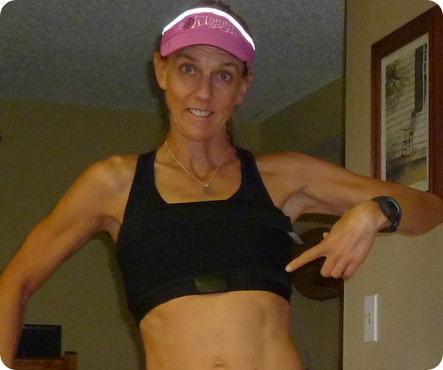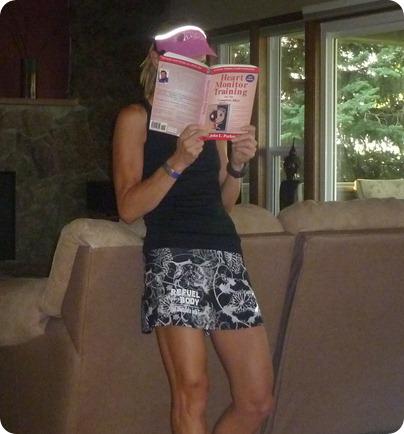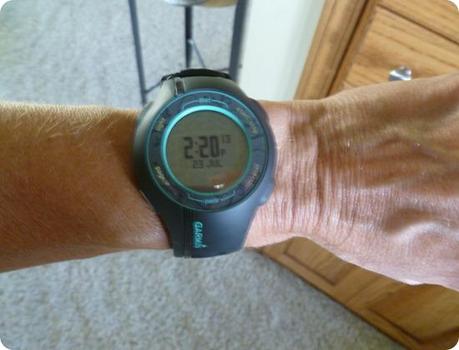Whoever said patience is a virtue definitely trained with a heart rate monitor before they started spewing out quotes.
There are 3 reasons I am late to the party and have put off using a heart monitor for so long:
- It’s confusing – What the hell does 70% of heart rate max mean? How do I figure out a resting or max heart rate? Who cares? Life is too short for this mess.
- It’s annoying – I do not want to strap on (I said strap on!) that chest thing every time I run. It will bother me and impede the growth of my breasts. I know they are still growing!
- It will make me slow down – I suspected I had been running at heart rates that were much too high. I knew if I started training with a monitor and attempting to keep within the right “zones,” I’d have to slow down. My ego would scream “loser!” “slacker!” and “lazy sack!,” and my neighbors would judge, that is if they cared.
What I’ve found is that only one of these is true: #3.
It’s not all that confusing and it’ s not at all annoying. But, once I strapped on the monitor, I’ve had to check my ego at the door and not judge myself based on pace. My one and only goal has become to stay in the appropriate heart rate zone for my workout. Period.

See? No big deal. And, it matches my bra.
In all of my prior training plans, I have set goals based on pace. The problem with this is that I was training at paces where I was exerting myself too much and didn’t even know it. I am positive this contributed to injury. When people say you over-train, it doesn’t mean you are necessarily running too many miles, etc. It means you are training at paces that do not improve performance over the long term. Paces that are likely too fast for your target heart rates.
If you don’t believe me, check out this article by Mark Allen, pro triathlete and six-time Ironman Triathlon World Champion. He sums all of this up very well – better than I could ever hope to.
Why Train with a Heart Rate Monitor?
I am no expert on this topic, so feel free to chime in. I’m just trying to learn all I can. Recently, I’ve read two books that address the subject: Rich Roll’s, Finding Ultra and John Parker’s, Heart Rate Training: the Compleat Idiot’s Guide (which I found online for .42¢. Yes, CENTS).

Here’s why I am chugging the Kool-Aid at this point:
- Most of us stink at gauging how hard we are working. Heart rate provides an objective gauge of exertion. It is usually more exact than your own perception of how hard you're working. This is important for people like me who are clueless and have to go balls to the wall all the time. I need permission to slow down.
- By training in the correct heart rate zone, you train your body to adapt. Soon you will be running faster at lower heart rates (this means faster with less exertion).
- Most people train in the “gray zone.” A place where too much effort is put out to strengthen the aerobic system, yet too little is put out to increase the anaerobic threshold. This is where I have spent most of my running life.
“It’s that level of effort that leaves you feeling nice and winded after a brisk run but yields little in terms of performance improvement. It undermines true progress. It leaves you tired, with little to no gains in either endurance or speed. It creates plateaus that stunt athletic development and often lead to injury.” (Rich Roll, Finding Ultra).
- Keep in mind, you will not always be running “slow.” With heart rate training, there will be specific workouts to improve speed, endurance and strength. The trick is that target heart rates vary and hard/easy days alternate.
- By staying at an aerobic level in training and racing, you can use fat as your fuel source – this gives you an unlimited source of fuel.
How Do You Get Started?
- Spend .42¢ on a book and/or read this article from Runner’s World.
- Get a watch with a heart rate monitor. I purchased the Garmin Forerunner 210, but there are many less expensive options, especially if you don’t care about having a GPS.

- Find your resting heart rate by recording your pulse when you wake up and before you get out of bed in the morning. Mine is 51 beats per minute (bpm).
- Find your max heart rate. There are formulas for this and you can also have it done at a lab. But, this is how I found mine:
- After warming up for a couple of miles, I ran as fast as I could for 2 to 3 minutes, then jogged for 1 minute.
- I repeated this 3 times and took the highest heart rate that was recorded. You can also do hill repeats.
- This is not exact, but it’s a good starting point. My max heart rate is 186 bpm. This could be low. If I see a higher number during a race or workout, that becomes my new max.
- Use a formula to figure out percentages of your max heart rate:
- 70% – 75% of Max (this is the zone where you do recovery and long runs): (Max minus resting HR) x .70 + (Resting HR). For me, this would be (186-51) x .70 + (51) = 145 to 152 bpms.
- 85% (zone for tempo runs): (Max minus resting HR) x .85 + (Resting HR). For me, this would be (186-51) x .85 + (51) = 165 bpms
- 90%-95% (zone for interval/speed workouts): (Max minus resting HR) x .90 + (Resting HR). For me, this would be (186-51) x .90 + (51) = 172 to 179 bpms
- Set up your training plan according to zones. Alternate hard and easy days. For example: Mon: 6 miles @ 70% of max heart rate. Tues: Warm up 1 mile @ 70%. Run 3 miles @ 85%. Cool down 1 mile @ 70%. Wed: 6 miles @70%. Thursday: Off. Friday 12 miles @ 70%.
How Does It Feel When You First Start?
- SLOW. Like, painfully so. Most of us have a groove we get into when we run. A pace we naturally gravitate towards. Running at 150 bpms has made me slow down at least one to two minutes per mile. Sometimes it is tough for me to run slow enough to stay at my target heart rate on my 70% runs. I’ve feel like I’m running through mud.
- A relief. Running has become fun again. I am not tired. I take in my surroundings. I can have conversations.
- Refreshing. I am recovering quickly. I have no aches or pains. The day after a longer run, I am able and ready to go again.
- In control. I finally feel like I am taking the reins with my running. It is no longer haphazard or based on someone else's plan. It is completely and totally tailored to where I am fitness-wise.
- Focused. Running slower has let me hone in on perfecting my form.
You may not be ready to take this on, or maybe you have been doing it for years. Whatever the case, heart rate training is a way to objectively gauge exertion and progress. I figure I have nothing to lose, so I’m going to try it for a few months and see what happens. Maybe I’ll become slower than I am already, but I doubt it. I’m already seeing progress.
Do you train with a heart rate monitor? Have you seen progress?
Any tips to add?
SUAR

